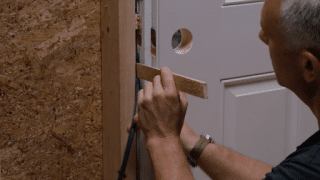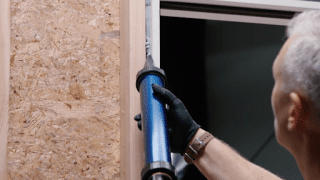
When your DIY project calls for the installation of a new door, you’ll want a base of knowledge about the two types of door units you can use: prehung and slab.
Interior door basics
Door installation can mean inserting a door into an existing door opening or existing door frame (these two terms are not quite synonymous), or it can mean installing a door in a wall that you are building from scratch.
- Installing into an existing door opening. This method applies when you have a door opening but no door frame or door itself. You will first need to build the door frame in the opening (most do this with door frame kits from a hardware store). Then you will install a slab door onto that new frame. You can also install a prehung door into the opening. Prehung door units come with a door slab already hung on frame hinges.
- Installing slab doors onto an existing frame. In many cases, you may have an existing door frame to work with. This means you can install a slab door onto the existing frame. You would buy the door slab, create a mortise for hinges, and then hang the slab on frame hinges.
- Building a door frame from scratch. If you are embarking on new construction of a wall, you will need to build a new door frame into that wall. This means you will build a door opening and either install a prehung door unit or hang a slab door.
What is a prehung door?
Prehung doors are special types of doors that come attached to an existing door frame. Rather than have to assemble a new frame within a door opening, you can install a complete prehung unit—including door slap, hinges, and frame—in one fell swoop.
Advantages of prehung doors
Contractors and DIY home renovators choose prehung doors for a number of reasons.
- They make great exterior entry doors. Exterior prehung doors are assembled to be weathertight at the factory. This spares you the extra work of figuring out how to weatherproof your doorway and cut out drafts.
- They can save you money. Prehung doors cost more off the shelf than slab doors. However you can end up saving money when it comes to installation fees. It might take a carpenter most of the day to build a door frame, chisel mortises, drill frame hinges, and successfully hang a door. Save on fees by letting that carpenter start off with a prehung unit.
- Quality control. The majority of prehung doors sold in hardware stores come from major manufacturers, which comes with a degree of quality control and precision manufacturing.
How is a prehung door installed?
Prehung doors slot into existing door openings. If you’re ready to install your own prehung door for a DIY project, follow this step-by-step guide as you work.
- Assemble equipment. To successfully install a prehung door, you will need the prehung door itself, wood shims, nails, a hammer, a hand saw, a circular saw, a file, sanding equipment, a tape measure, and a pencil. Depending on your door model, you may also need extra hardware like a strike plate.
- Unwrap the door. Keep the prehung door in its packing restraints until you are ready to install it. This will keep it stable and prevent it from swinging. (Prehung door frames can be surprisingly flimsy until they are bolted to a wall.)
- Prepare your rough door opening for installation. Your opening should be a half-inch wider and taller than the prehung unit you’re about to install. Make sure all surfaces are completely level with no twists and no nails or screws sticking out of the rough opening.
- Trim your door jamb to fit the opening. Use one of your saws, a file, or a sanding device to trim your door jamb to the necessary size. Plan on a two-inch gap between the bottom of your door and an unfinished floor, or a half-inch gap between the bottom of your door and a floor with finish.
- Level and attach the hinge side of the doorframe. Start installing the door on its hinge side. You can temporarily hold it in place using wood shims and finishing nails.
- Move on to the latch side. Once your hinge side is set in place, move on to the latch side of the doorframe. Once again use shims and finishing nails to attach the frame to the rough door opening.
- Attach the top of the frame. Insert a shim into the very top of the prehung unit. Nail it in with finish nails.
- Continue to add shims where needed. A typical prehung door will have wood shims every foot (twelve inches) to hold it in place and maintain its rectangular shape.
- Finish with plaster and trim. With the prehung door properly nailed into the rough opening, you’re ready to add plaster and door trim to finish the project on an aesthetic level.
What is a slab door?
Slab doors are door panels that arrive detached from a door frame. They can function as both interior doors and exterior entry doors. Some come with pre-drilled mortises for hardware like door hinges, door latches, and faceplates. Others come as solid wood slabs and the installer must chisel out their own mortises.
You get a lot of options when it comes to slab doors.
When your DIY project calls for the installation of a new door, you’ll want a base of knowledge about the two types of door units you can use: prehung and slab.
Interior door basics
Door installation can mean inserting a door into an existing door opening or existing door frame (these two terms are not quite synonymous), or it can mean installing a door in a wall that you are building from scratch.
- Installing into an existing door opening. This method applies when you have a door opening but no door frame or door itself. You will first need to build the door frame in the opening (most do this with door frame kits from a hardware store). Then you will install a slab door onto that new frame. You can also install a prehung door into the opening. Prehung door units come with a door slab already hung on frame hinges.
- Installing slab doors onto an existing frame. In many cases, you may have an existing door frame to work with. This means you can install a slab door onto the existing frame. You would buy the door slab, create a mortise for hinges, and then hang the slab on frame hinges.
- Building a door frame from scratch. If you are embarking on new construction of a wall, you will need to build a new door frame into that wall. This means you will build a door opening and either install a prehung door unit or hang a slab door.
What is a prehung door?
Prehung doors are special types of doors that come attached to an existing door frame. Rather than have to assemble a new frame within a door opening, you can install a complete prehung unit—including door slap, hinges, and frame—in one fell swoop.
Advantages of prehung doors
Contractors and DIY home renovators choose prehung doors for a number of reasons.
- They make great exterior entry doors. Exterior prehung doors are assembled to be weathertight at the factory. This spares you the extra work of figuring out how to weatherproof your doorway and cut out drafts.
- They can save you money. Prehung doors cost more off the shelf than slab doors. However you can end up saving money when it comes to installation fees. It might take a carpenter most of the day to build a door frame, chisel mortises, drill frame hinges, and successfully hang a door. Save on fees by letting that carpenter start off with a prehung unit.
- Quality control. The majority of prehung doors sold in hardware stores come from major manufacturers, which comes with a degree of quality control and precision manufacturing.
How is a prehung door installed?
Prehung doors slot into existing door openings. If you’re ready to install your own prehung door for a DIY project, follow this step-by-step guide as you work.
- Assemble equipment. To successfully install a prehung door, you will need the prehung door itself, wood shims, nails, a hammer, a hand saw, a circular saw, a file, sanding equipment, a tape measure, and a pencil. Depending on your door model, you may also need extra hardware like a strike plate.
- Unwrap the door. Keep the prehung door in its packing restraints until you are ready to install it. This will keep it stable and prevent it from swinging. (Prehung door frames can be surprisingly flimsy until they are bolted to a wall.)
- Prepare your rough door opening for installation. Your opening should be a half-inch wider and taller than the prehung unit you’re about to install. Make sure all surfaces are completely level with no twists and no nails or screws sticking out of the rough opening.
- Trim your door jamb to fit the opening. Use one of your saws, a file, or a sanding device to trim your door jamb to the necessary size. Plan on a two-inch gap between the bottom of your door and an unfinished floor, or a half-inch gap between the bottom of your door and a floor with finish.
- Level and attach the hinge side of the doorframe. Start installing the door on its hinge side. You can temporarily hold it in place using wood shims and finishing nails.
- Move on to the latch side. Once your hinge side is set in place, move on to the latch side of the doorframe. Once again use shims and finishing nails to attach the frame to the rough door opening.
- Attach the top of the frame. Insert a shim into the very top of the prehung unit. Nail it in with finish nails.
- Continue to add shims where needed. A typical prehung door will have wood shims every foot (twelve inches) to hold it in place and maintain its rectangular shape.
- Finish with plaster and trim. With the prehung door properly nailed into the rough opening, you’re ready to add plaster and door trim to finish the project on an aesthetic level.
What is a slab door?
Slab doors are door panels that arrive detached from a door frame. They can function as both interior doors and exterior entry doors. Some come with pre-drilled mortises for hardware like door hinges, door latches, and faceplates. Others come as solid wood slabs and the installer must chisel out their own mortises.
You get a lot of options when it comes to slab doors.
- Solid wood doors. Solid wood slab doors offer a classic look for both interior and exterior applications. Solid wood doors offer insulation from the weather and noise, though some more modern options are better at blocking the outside. Solid wood is the most common option historically, and most vintage doors are solid.
- Solid core doors. Solid core slab doors are made from composite wood or other materials, which includes MDF, particle board, plywood, glass fibers, and even foam. They can come finished with a solid wood veneer that makes them look quite similar to a solid wood door. When it comes to temperature insulation and sound absorption, solid core slab doors excel. Their dense, multi-layer construction traps heat and sound better than solid wood or hollow core options.
- Hollow core doors. These are a lightweight and low-cost option for interior doors, particularly for closet doors. They will not do much in the way of insulating temperature or absorbing the sound of your roommate watching daytime soap operas, but if that is not a consideration, hollow core doors can be a great budget option.
- Fiberglass doors. Fiberglass is a sturdy wood alternative that has impressive insulating properties. Fiberglass slab doors tend to be more expensive than their wood counterparts, so people often install them as an exterior entry door and then use some version of a wood door for their interior door needs. Today’s fiberglass doors can be made with wood textures that can fool many people into thinking they are made from real wood.
- Metal doors. Metal doors are typically made of an aluminum/steel composite. Although they are heavy and a bit impersonal, they make excellent exterior doors and work especially well as security doors.
Advantages of slab doors
Slab doors are both cheaper and more versatile than prehung door units. Here are some reasons why builders opt for a slab door.
- Lower retail cost. A slab door is cheaper than a prehung unit, so you will pay less at your local hardware store. When pricing home repairs, however, you must factor in the cost of labor. If you need to hire someone to install your door for you, you will likely pay more money to install a slab door over a prehung door. If you plan to install the door yourself, you can save money overall.
- Greater array of door design options. It is relatively easy to find standalone slab doors made from a variety of materials and in a variety of styles. From solid wood doors to solid core doors to hollow core doors to fiberglass and metal doors, you should encounter little difficulty in sourcing what you need. You will also have a greater choice of aesthetic designs.
- Slab doors typically fit more easily into existing door openings. Prehung doors come with their own door frame, and those frames don’t always cooperate with existing door openings. Slab doors are much easier to shape to the size of your existing frame.
How is a slab door installed?
Hanging a slab door can be a bit trickier than installing a prehung door unit. If you’re up for a slightly bigger challenge, dive in.
- Assemble your tools. To hang a slab door, you will need the actual door slab, doorknob, face plate, strike plate, and hinges. You will also need the following tools: hammer, nails, power drill with various bits, wood chisel, pry bar, speed square, spring clamps, and a pencil.
- Match your new slab door to the one you are replacing. The fastest way to create mortises on your new slab door is to copy the configuration of the door you are replacing. Remove the doorknob in your old door and place the two doors side-by-side on the floor with their hinge sides pointing upward. If you like, you can clamp them together using spring clamps. This will keep them in place.
- Use the speed square to mark your mortise cuttings. Take your speed square and pencil and copy the exact location and dimensions of your old door’s hinges onto the hinges of the new slab door. Measure from the top and bottom of the new door to make sure your markings are in the exact spot they need to be.
- Use the chisel to cut out the proper space mortise. Make sure you use a sharp, high-quality chisel to do the most precise work possible. Make the mortise area as flat and smooth as possible. The sharper your chisel, the easier this step will be.
- Screw in the hinges. Using your power drill, remove the hinges from your old door and install them into your new door. To be on the safe side, you may want to drill pilot holes before moving on to the screws themselves. It is crucial that the hinges are flush with the side surface of the door. If they stick out too much, you will need to deepen your mortise. If they are too recessed, you will need to shim your mortise with either cardboard or a very thin strip of plywood. Once you have the hinges completely flush, you’re ready to move on to the next step.
- Hang the door. Place the slab door inside the doorframe. Use the pry bar to raise the door to the exact level of the existing drill holes on the door frame. When you have it perfectly lined up, drill the hinges into the existing holes. You must do this exactly right, or you’ll accidentally enlarge the door jamb’s drill holes and make the door unstable.
- Install your remaining hardware. Once your door is hung, you can add the remaining hardware like a doorknob and strike plate. Save this step for last because it’s a lot easier to tweak the positioning of a strike plate than the position of a hanging door.
MT Copeland offers video-based online classes that give you a foundation in construction fundamentals with real-world applications, like how house framing works. Classes include professionally produced videos taught by practicing craftspeople, and supplementary downloads like quizzes, blueprints, and other materials to help you master the skills.






